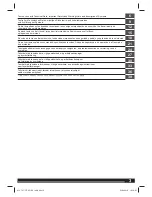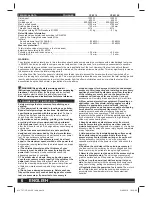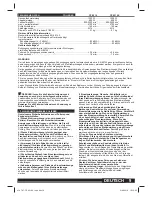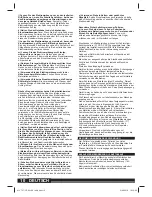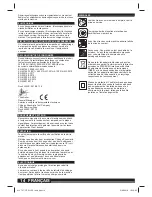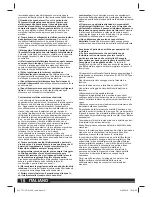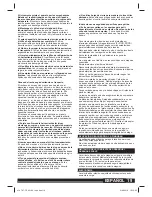
6
CP 8210
CP 8210 E
.......................1200 W .........................1200 W
.........................600 W ...........................600 W
................900-2500 min
-1
..............900-2500 min
-1
.......................4700 min
-1
.....................4700 min
-1
.........................150 mm ........................150 mm
.......................M 14 ............................M 14
..........................2,1 kg ............................2,1 kg
...........................82 dB(A) .......................82 dB(A)
...........................93 dB(A) .......................93 dB(A)
........................<2,5 m/s
2
.......................<2,5 m/s
2
..........................1,5 m/s
2
.........................1,5 m/s
2
ENGLISH
TECHNICAL DATA
POLISHER
Rated input ..............................................................................
Output ......................................................................................
No-load speed ........................................................................
Max. no-load speed .................................................................
Grinding disk diameter.............................................................
Thread of work spindle ...........................................................
Weight according EPTA-Procedure 01/2003 ...........................
Noise/Vibration Information
Measured values determined according to EN 60745.
Typically, the A-weighted noise levels of the
tool are:
Sound pressure level (K = 3 dB(A)) .......................................
Sound power level (K = 3 dB(A)) ............................................
Wear ear protection!
Total vibration values (vector sum in the three axes)
determined according to EN 60745:
Polishing: vibration emission value a
h
.....................................
Uncertainty K = ........................................................................
WARNING! Read all safety warnings and all
instructions, including those given in the accompanying
brochure
. Failure to follow the warnings and instructions
may result in electric shock, fi re and/or serious injury.
Save all warnings and instructions for future reference.
POLISHER SAFETY INSTRUCTIONS
Safety warnings that are common for polishing and
sanding:
a) This power tool is intended to function as a polisher.
Read all safety warnings, instructions, illustrations and
specifi cations provided with this power tool.
Failure to
follow all instructions listed below may result in electric
shock, fi re and/or serious injury.
b) Operations such as sanding, grinding, wire brushing,
or cutting-off are not recommended to be performed
with this power tool.
Using the electric tool for purposes
other than those for which it is designed may cause dangers
and injuries.
c) Do not use accessories which are not specifi cally
designed and recommended by the tool manufacturer.
Just because the accessory can be attached to your power
tool, it does not assure safe operation.
d) The rated speed of the accessory must be at least
equal to the maximum speed marked on the power tool.
Accessories running faster than their rated speed can break
and fl y apart.
e) The outside diameter and the thickness of your
accessory must be within the capacity rating of your
power tool.
Incorrectly sized accessories cannot be
adequately guarded or controlled.
f) The arbour size of wheels, fl anges, backing pads or
any other accessory must properly fi t the spindle of the
power tool.
Accessories with arbour holes that do not
match the mounting hardware of the power tool will run out
of balance, vibrate excessively and may cause loss of
control.
g) Do not use a damaged accessory. Before each use
inspect the accessory such as backing pad for cracks,
tear or excess wear. If power tool or accessory is
dropped, inspect for damage or install an undamaged
accessory. After inspecting and installing an accessory,
position yourself and bystanders away from the plane
of the rotating accessory and run the power tool at
maximum no-load speed for one minute.
Damaged
accessories will normally break apart during this test time.
h) Wear personal protective equipment. Depending on
application, use face shield, safety goggles or safety
glasses. As appropriate, wear dust mask, hearing
protectors, gloves and shop apron capable of stopping
small abrasive or workpiece fragments.
The eye
protection must be capable of stopping fl ying debris
generated by various operations. The dust mask or
respirator must be capable of fi ltrating particles generated
by your operation. Prolonged exposure to high intensity
noise may cause hearing loss.
i) Keep bystanders a safe distance away from work
area.
Anyone entering the work area must wear personal
protective equipment.
Fragments of workpiece or of a broken
accessory may fl y away and cause injury beyond immediate
area of operation.
j) Hold power tool by insulated gripping surfaces only,
when performing an operation where the cutting
accessory may contact hidden wiring or its own cord.
Cutting accessory contacting a „live“ wire may make
exposed metal parts of the power tool „live“ and shock the
operator.
k) Position the cord clear of the spinning accessory.
If
you lose control, the cord may be cut or snagged and your
hand or arm may be pulled into the spinning accessory.
l) Never lay the power tool down until the accessory has
come to a complete stop.
The spinning accessory may
grab the surface and pull the power tool out of your control.
m) Do not run the power tool while carrying it at your
side.
Accidental contact with the spinning accessory could
snag your clothing, pulling the accessory into your body.
n) Regularly clean the power tool’s air vents.
The motor’s
fan will draw the dust inside the housing and excessive
accumulation of powdered metal may cause electrical
hazards.
WARNING
The vibration emission level given in this information sheet has been measured in accordance with a standardised test given
in EN 60745 and may be used to compare one tool with another. It may be used for a preliminary assessment of exposure.
The declared vibration emission level represents the main applications of the tool. However if the tool is used for diff erent
applications, with diff erent accessories or poorly maintained, the vibration emission may diff er. This may signifi cantly increase
the exposure level over the total working period.
An estimation of the level of exposure to vibration should also take into account the times when the tool is switched off or
when it is running but not actually doing the job. This may signifi cantly reduce the exposure level over the total working period.
Identify additional safety measures to protect the operator from the eff ects of vibration such as: maintain the tool and the
accessories, keep the hands warm, organisation of work patterns.
414 797 - CP 8210 E.indd Abs16
414 797 - CP 8210 E.indd Abs16
31.08.2018 16:19:02
31.08.2018 16:19:02



